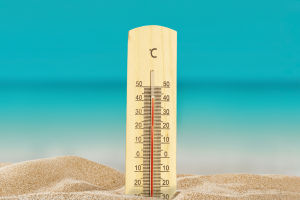The impact of climate change is particularly significant in the Arctic, especially as global warming accelerates, with temperatures in the Arctic rising two to three times faster than the global average.
This phenomenon is called the "Arctic amplification effect," meaning that climate change in the Arctic is happening much faster than in other regions. This, in turn, has a profound impact on the global climate system and local ecosystems.
One of the most obvious effects is the continued reduction of Arctic sea ice. Every year, Arctic sea ice forms in the winter and partially melts in the summer, but as temperatures rise, the area covered by sea ice shrinks year after year.
Since 1979, the area of Arctic sea ice has decreased by about 40%. This change has not only profoundly impacted the Arctic ecosystem, but also exacerbated global climate change.
The reduction in sea ice directly affects the Arctic ecosystem, especially species that rely on sea ice for survival. For example, polar bears are emblematic of the polar environment.
They rely on sea ice to hunt seals, but as sea ice shrinks, they must swim farther to find food, facing the dilemma of excessive energy consumption. The reduction in sea ice also threatens the survival of other species such as seals and walruses, which depend on sea ice as a habitat.
The entire food chain is affected by this change, from tiny plankton in the ocean to top predators, and the imbalance of the ecosystem has already begun to emerge.
Melting glaciers are another key manifestation of climate change in the Arctic. The Greenland ice sheet stores the second-largest amount of fresh water in the world. Its accelerated melting will not only cause global sea levels to rise but may also disrupt ocean circulation patterns, thus affecting the global climate.
In recent years, the rate of melting of the Greenland ice sheet has reached unprecedented levels, releasing hundreds of billions of tons of freshwater into the ocean each year. This phenomenon is triggering a chain reaction globally, especially in coastal areas, where rising sea levels have become an increasingly serious threat.
At the same time, the permafrost in the Arctic is gradually thawing. Permafrost is long-frozen soil that stores a large amount of organic matter and carbon. Once the permafrost begins to thaw, this carbon will be released into the atmosphere, further exacerbating global warming.
Studies estimate that the amount of carbon stored in Arctic permafrost is about twice the amount of carbon in the atmosphere, and thawing may cause irreversible climate impacts.
In addition, the thawing of permafrost leads to surface subsidence, posing a threat to infrastructure in the Arctic region and affecting the lives and economic activities of residents.
Communities such as the Inuit, and the indigenous people of the Arctic, have already begun to feel the direct impact of climate change. For many years, their lifestyle has been closely tied to the natural environment, relying on sea ice, wildlife, and fishery resources.
However, as sea ice decreases, hunting and fishing become more difficult, and food sources are threatened. Many Arctic communities are also facing the dilemma of migration.
The thawing of permafrost has led to unstable foundations, and erosion in coastal areas has increased the risk of floods, forcing residents to leave homes where they have lived for generations. This is not only a material loss, but also a huge blow to local culture and social structures.
Changes in the Arctic have not only affected the local ecosystem and the lives of its residents, but they have also caused a wide range of chain reactions around the world.
As sea ice decreases, Arctic shipping routes are gradually becoming more accessible, especially in summer, providing new opportunities for the global shipping industry.
However, the opening of the route has also triggered debates on environmental protection and geopolitics. The Arctic region is rich in resources, with significant amounts of oil, natural gas, and minerals, and the retreat of ice and snow has made the development of these resources more realistic.
Yet, resource development could further exacerbate the global climate crisis, as the extraction of fossil fuels means more greenhouse gas emissions.
Climate change is transforming the Arctic at an unprecedented rate. The reduction of sea ice, melting glaciers, thawing permafrost, and the resulting changes in ecosystems profoundly impact the flora, fauna, and human communities in the Arctic.
This is not just a problem for the Arctic, but a global challenge. To curb these changes, the world must strengthen cooperation and work to create a sustainable future for this important ecosystem by reducing emissions, protecting the natural environment, and supporting adaptation measures in Arctic communities.


